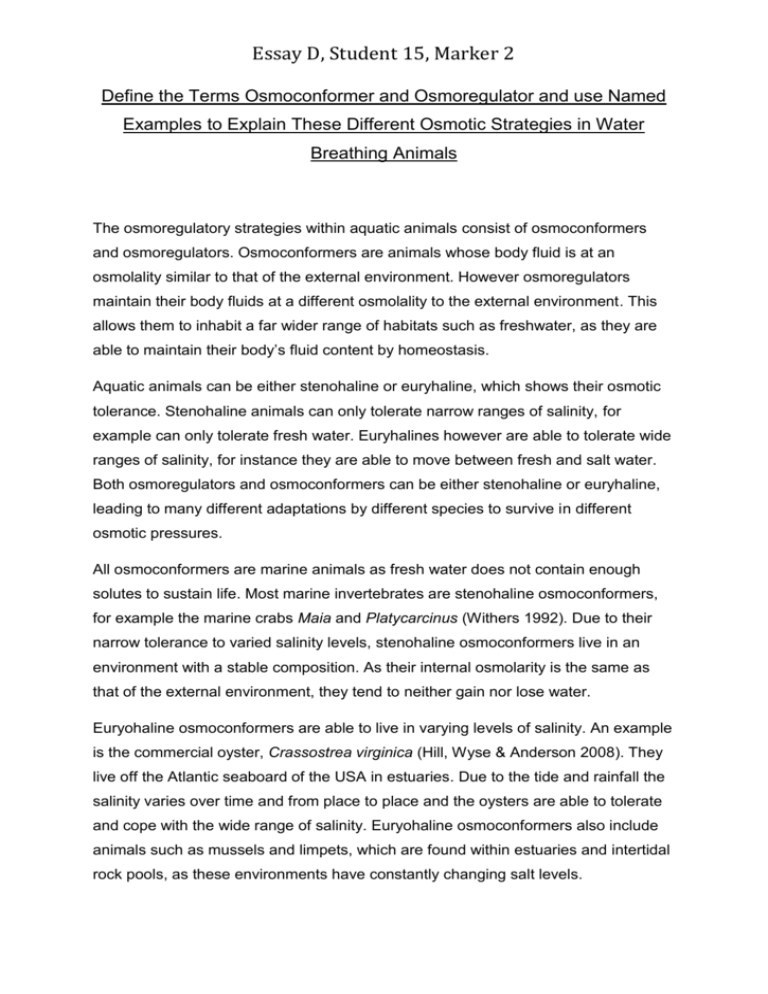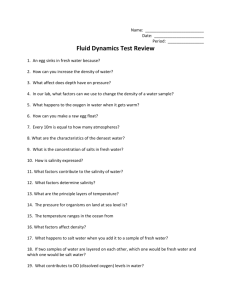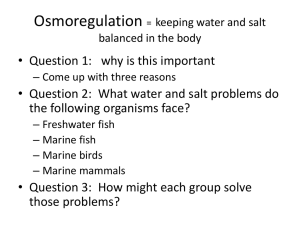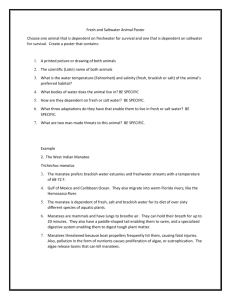pg2essay15
advertisement

Essay D, Student 15, Marker 2 Define the Terms Osmoconformer and Osmoregulator and use Named Examples to Explain These Different Osmotic Strategies in Water Breathing Animals The osmoregulatory strategies within aquatic animals consist of osmoconformers and osmoregulators. Osmoconformers are animals whose body fluid is at an osmolality similar to that of the external environment. However osmoregulators maintain their body fluids at a different osmolality to the external environment. This allows them to inhabit a far wider range of habitats such as freshwater, as they are able to maintain their body’s fluid content by homeostasis. Aquatic animals can be either stenohaline or euryhaline, which shows their osmotic tolerance. Stenohaline animals can only tolerate narrow ranges of salinity, for example can only tolerate fresh water. Euryhalines however are able to tolerate wide ranges of salinity, for instance they are able to move between fresh and salt water. Both osmoregulators and osmoconformers can be either stenohaline or euryhaline, leading to many different adaptations by different species to survive in different osmotic pressures. All osmoconformers are marine animals as fresh water does not contain enough solutes to sustain life. Most marine invertebrates are stenohaline osmoconformers, for example the marine crabs Maia and Platycarcinus (Withers 1992). Due to their narrow tolerance to varied salinity levels, stenohaline osmoconformers live in an environment with a stable composition. As their internal osmolarity is the same as that of the external environment, they tend to neither gain nor lose water. Euryohaline osmoconformers are able to live in varying levels of salinity. An example is the commercial oyster, Crassostrea virginica (Hill, Wyse & Anderson 2008). They live off the Atlantic seaboard of the USA in estuaries. Due to the tide and rainfall the salinity varies over time and from place to place and the oysters are able to tolerate and cope with the wide range of salinity. Euryohaline osmoconformers also include animals such as mussels and limpets, which are found within estuaries and intertidal rock pools, as these environments have constantly changing salt levels. Essay D, Student 15, Marker 2 Most osmoregulators are stenohaline. They can be either hypo-osmotic, where their body fluid has a lower osmolality than the external environment, meaning salt moves in and water moves out. Or hyper-osmotic, where their body fluid has a higher osmolality than the external environment, so water moves in and salts move out. All freshwater animals, such as Yellow perch, Perca flavescens, are hyperosmoregulators. Despite the scales and mucous covered bodies of fresh water fish which are almost impermeable to water, it still enters via osmosis across the gills, due to the thin membrane (Hickman et.al. 2007) Adaptations to combat the loss of salts and gain of water by these animals is by producing large amounts of very dilute urine, as their kidneys are specially adapted to reabsorb the maximum amount of NaCl. They produce about 5-15% of their body mass of urine each day, and secrete urine about once every 20 minutes. They gain some salts from their diet and do not need to drink, as this would lead to more water within their bodies. They have specialised salt absorbing cells located on the gill epithelium, which are rich in mitochondria. These cells actively uptake salts from the surrounding water equalising the loss to the environment. All marine teleosts, such as Atlantic cod, Gadus morhua, are hypo-osmoregulators. This leads to dehydration due to the loss of water via osmosis, and an increase in salt concentration within the body. Adaptations of marine fish include drinking large volumes of sea water, up to 25% of its body mass each day. Then many of the salts from the water are carried by the blood to the gills, where specialised chloride cells, which are also mitochondria rich, that actively transport chloride ions out of the body, this then leads to the diffusion of sodium ions out of the body also (Campbell & Reece 2008). The kidneys are also highly adapted and have a reduced or even absent glomerulus leading to the excretion of excess ions through urine and faeces, mostly calcium, magnesium and sulphate ions (Hickman et.al 2007). To help prevent water loss they produce very small amounts of very concentrated urine, only 1% of the volume produced by fresh water fish, secreting urine about once every 3 days. Not all marine fish however are hypo-osmoregulators. Marine sharks, such as the dogfish shark, Squalus acanthias, are often considered osmoconformers (Campbell & Reece 2008). They have an internal osmolality that is close to that of the sea, but is actually slightly higher. This is because their tissue contains large amounts of Essay D, Student 15, Marker 2 urea, and their body fluid contains an organic molecule that protects against damage by urea, as well as salt. As their body fluid has a slightly higher concentration of salinity then the sea, water enters the body by osmosis and through food. Adaptations to combat this are that sharks do not drink and some is removed through urine or faeces. Sharks also have a specialised excretory organ, called the rectal gland to excrete excess salt. Euryohaline osmoregulators are fish such as the European eel, Anguilla Anguilla, which is catadromous, meaning they spend most of their lives in fresh water but migrate to the sea to spawn. And also Atlantic salmon, Salmo salar, which is anadromous, as they spend most of their adult lives within the sea, but return to fresh water to spawn. The migration from a marine environment to a fresh water environment leads to a dramatic change in the salmon’s osmoregulatory status. They are able to osmoregulate the same way as hypo-osmoregulators within the sea, drinking large volumes of water, actively excreting excess salt and producing small quantities of concentrated urine and faeces. However when they are in fresh water they are able to act as hyper –osmoregulators. They stop drinking, actively uptake salts from the surrounding water and produce large amounts of dilute urine. These different techniques show the multiple ways in which different water breathing animals have evolved and adapted to survive within the aquatic environment, both osmoconformers and osmoregulators alike. References Campbell, N.A. Reece, J.B. Urry, L.A. Cain, M.L. Wasserman, S.A. Minorsky, P.V. Jackson, R.B. (2008) Biology (8th edn). Pearson Benjamin Cummings, San Francisco. Hickman, C.P. Roberts, L.S. Keen, S.L. Larson, A. Eisenhour, D.J. (2007) Animal Diversity (4th edn). The McGraw-Hill Companies, Inc., New York. Hill, R.W. Wyse, G.A. Anderson, M. (2008). Animal Physiology (2nd edn). Sinauer Associates, Inc., Massachusetts. Withers, P.C. (1992). Comparative Animal Physiology. Saunders College Publishing, Florida.






